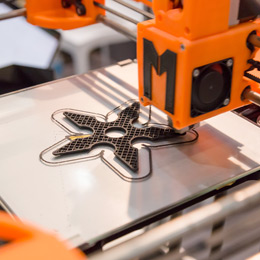
The printing industry is experiencing substantial innovation, especially in the area of 3D printing, also known as additive manufacturing or scalable digital manufacturing (SDM). Historically, most 3D printer users have been large manufacturers and educational institutions since the cost and space needed to use these printers was generally prohibitive for small businesses and consumers.
Over the next five years it is anticipated these machines will penetrate deeper into the small- and medium-sized businesses and healthcare markets, bringing in many new participants. One reason is the increasing assortment and falling cost of printers. This opens the door for smaller organizations to cost-effectively purchase and utilize this kind of printing technology.
Insights Into the Various Industries Utilizing 3D Printers
As the barriers of entry decrease, we see an expanding use of these printers for industries such as hospitals, medical and dental laboratories, toy manufacturers, packaging firms, machine shops, jewelers and sporting goods manufacturers. One example of increased use of the 3D printing module is in the dental field. With multiple specialized materials, it has the versatility to handle a variety of dental and orthodontic applications including stone models, surgical guides, veneer or denture try-ins and delivery trays.
Additionally, the materials available for 3D printing have come a long way and can be implemented in nearly any industry. Available substrates and materials include plastics, metals, paper, bio materials, even food as chocolatiers are seizing this new technology.
Effectively Underwriting 3D Printer Leases to Mitigate Collateral Risk
Part of mitigating the risk of utilizing a tool like a 3D printer is that the cost of materials and labor significantly decrease. For example, an industrial manufacturer who has a process that traditionally requires weeks to produce a one-off product with fabrication costs of up to $50,000 - $100,000 may now produce that same product in a few days and at a fraction of the cost.
As lenders look to extend credit to these organizations, they should be asking for an ROI assessment to assist in determining if the transaction will cash flow. Traditional banks are going to have a harder time with this due to heavy regulations. However, independent or alternative financing organizations like Ascentium Capital, have the advantage of flexibility over bank-sourced leasing companies as they may approve transactions weighing the decision based on alternative equipment justifications or different risk evaluators.
Secondly, a creditor must look at the obsolescence issue as these 3D printers categorically fall anywhere between a copy machine and a CNC lathe, making it difficult to successfully assign a residual price point. A good rule of thumb is that smaller 3D printers wear out more quickly and are susceptible to obsolescence, whereas larger units tend to carry value longer and can be overhauled or remanufactured. Therefore, larger equipment has a longer overall life helping to prove long term value.
Bundling of Software, Services and Equipment When Financing
There is a theme when looking at industry trends and commercial client expectations for new 3D printing technology integration: an all-inclusive simple payment plan that includes hardware, software, training, and peripherals. You see this with cable, internet and phone where companies successfully bundle several services and technology solutions into one monthly payment. Forward thinking companies are revising their sales approach by offering monthly payments under an OPEX or CAPEX program.
There are also a number of behind-the-scenes products driving the growth of this industry. Software, scanners and as mentioned earlier, the additives themselves are rapidly expanding the capability of these machines. Software is a necessary add-on for just about any 3D printer purchase. These licenses can be included into the financing agreement and are essential to the printer’s operation.
When it comes to maintenance, a service agreement for a 3D printer is a tough decision. Most 3D printers come with the first year’s maintenance included, but the question remains: Do you wrap year two, three and beyond into the financing? The manufacturer and reseller certainly encourage clients to include it, but the agreement can also be negotiated to be paid on an annual basis.
OPEX leases come with a much lower monthly payment, allowing firms to purchase a more expensive machine that provides greater capabilities and efficiencies. They can also classify this payment as a rental expense that may lower the firm’s taxable income. This can help with obsolescence as there is greater flexibility at the end of the term.
CAPEX leases provide the client with knowledge that they may own the machine when the finance term is complete. There are also potential Section 179 tax savings to consider. Companies should consult their tax advisor as to which type of finance product would be most beneficial for their organization.
The future is bright for the 3D printing industry. Lenders who take the time to understand this unique vertical can carve out another niche within their portfolio. They will need to be diligent in underwriting successful structures for the right clients.